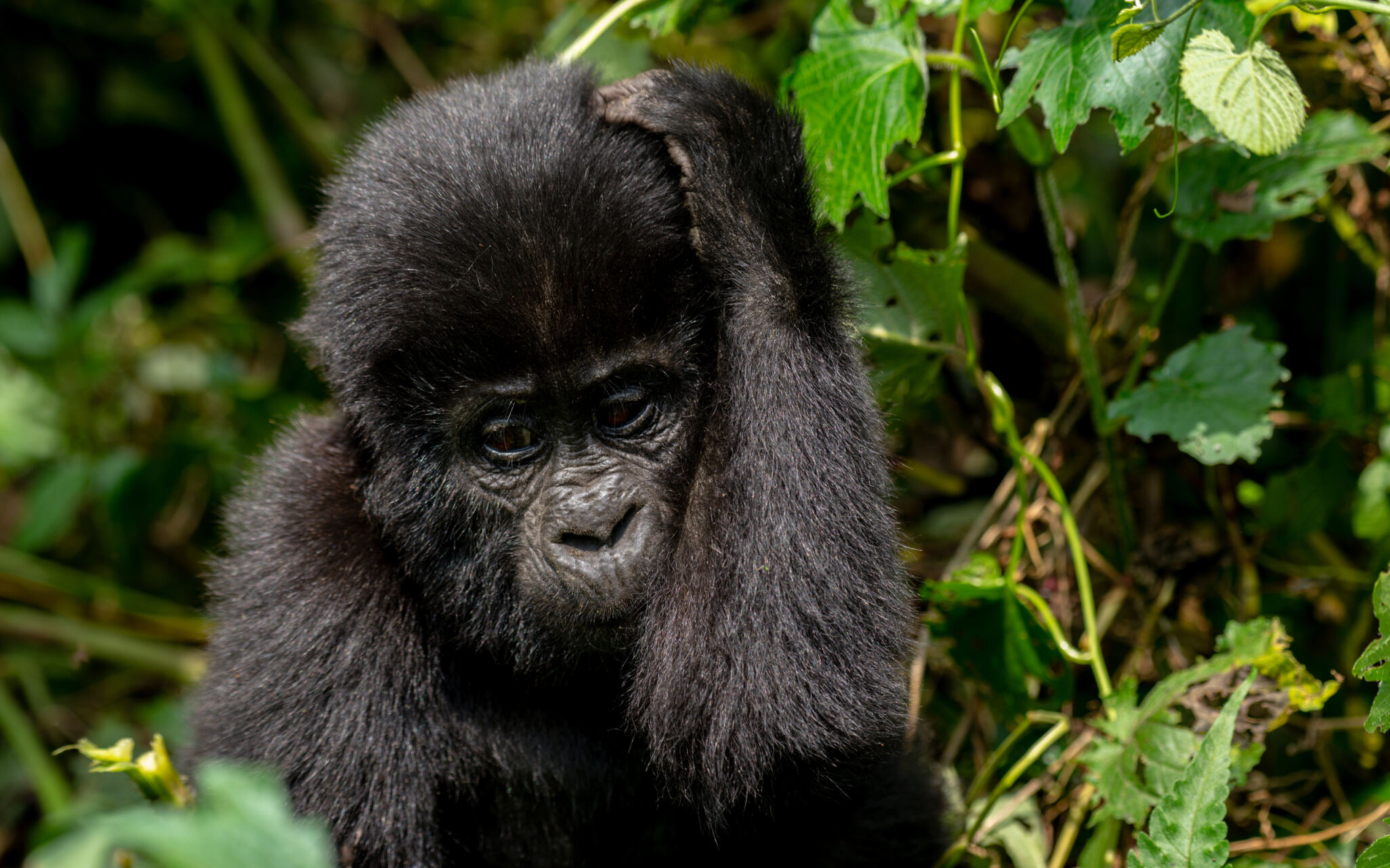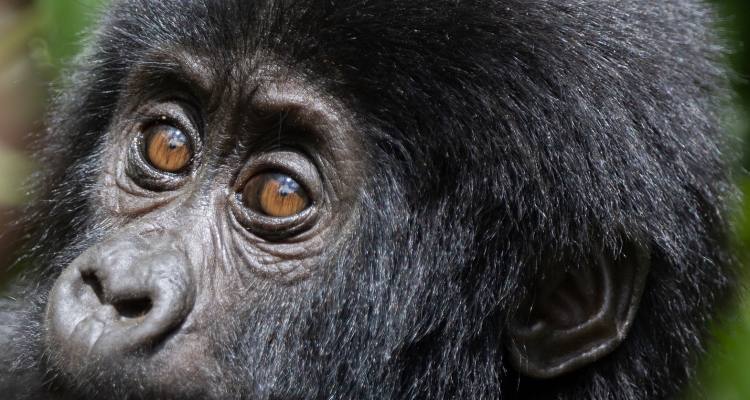Gorilla Trekking in Uganda
Uganda is home to half the world’s Mountain Gorilla population. Seeing these animals up close in their natural habitat is one of the most impressive wildlife encounters in Africa. Visiting the gorillas directly supports conservation efforts and population growth.
Ultimate travel Guide to Gorilla Trekking in Uganda in 2025 & 2026
1.Where can I track gorillas in Uganda?
Uganda as a country has two gorilla trekking destinations: Bwindi Impenetrable National Park and Mgahinga Gorilla National Park.
Bwindi Impenetrable is by far the more popular choice as the park contains half of the mountain gorilla population, your gateway for fly-in safaris, and has a greater range of accommodation options ranging from mid-range lodges to ultra-luxury lodges.
Which park you visit will depend on your wider travel plans and the time you have available. There is no difference in permit prices or chances of sightings across the two parks.
As you’ll notice on the Ugandan travel Map, both Bwindi and Mgahinga are in the deep southwestern pocket of Uganda, on the border with Rwanda to the south and the DRC to the west.
Many of Uganda’s safari destinations are also found in the south-west. This makes it easy to combine a savannah safari with gorilla trekking to create a single itinerary bursting with once-in-a-lifetime experiences.

Uganda is a small hidden gem with unforgettable adventure soul memories just packed in the pearl of Africa.
2.Securing a gorilla permit
Gorilla permits are currently fixed at $800 USD per person.
The permits are no longer discounted during the rainy season, but they are easier to secure at short notice if you are travelling during Uganda’s long rainy season (March to May) or in the short rainy season (October to November).
For peak travel months (January – February and June – August), permits can sell out as early as a year in advance. The permit numbers are strictly limited, so we strongly recommend planning early.
Another added advantage of visiting the gorillas in Uganda is the relatively cheap permit costs compared to neighboring Rwanda where permit prices sit at an eye-watering $1500 USD per person for trekking gorillas in the famous Volcanoes National Park.
If one hour of contact is just not enough, if you are a wildlife photographer, or if you are simply fascinated by the behavior of these incredible animals, then it is also possible to join the Gorilla habituation team in the Rushaga sector of southern Bwindi. This experience includes up to four hours with the family, observing the individuals and their interactions, and costs $1,600 per person.
Gorilla permits are non-refundable, because the gorilla permits are sold and secured on booking from the Uganda Wildlife Authority.
3.How difficult is the gorilla trekking?
You should be prepared to walk through a challenging terrain of steep ridges and valleys, following animal paths through tangled undergrowth for about 3 hours, although sometimes contact can be made after 35 minutes, and other times 6 hours.
During the rainy season, the trekking routes can become very slippery and much more challenging. The rains can sometimes bring the gorillas to lower ground which can shorten the length of the trek, but you should be prepared to trek for up to 6 hours in any case.
The gorillas typically prefer the highlands, so the trek is made more challenging due to periods of steep gradients.
4.What to wear on a gorilla trek?
Trekking through the dense tropical rainforest thickets at both Bwindi or Mgahinga require a well-considered get-up. Since you’re on the equator, you will need to be prepared for rains no matter what time of year you are travelling. While you want clothing that protect you from the elements, you also need to keep cool for the 2-6-hour trekking, so you’ll want light and comfortable clothing.
The essential clothing code of conduct;
Good quality, robust, waterproof trekking shoes/boots.
Light waterproof trekking pants/trousers.
Long socks to pull up over your pants/trousers to keep your skin protected. Waterproof Garters are an even better option.
Waterproof jacket/rain coat/wind breaker
Long sleeve trekking T-shirt
Gardening/outdoor gloves to protect against thorns and allow you to push through the more difficult parts of the trail without worrying about what you’re grabbing on to!
We also recommend bringing a few sachets of re-hydration salts. Water is of course provided for the treks, but you can often find yourself dehydrated after a full day of trekking and the salts can provide quick relief. Walking sticks are provided for you.
5.The rules around gorilla trekking
Before you start any gorilla trek, you will be given a brief from your guide about the rules to follow throughout your time tracking the gorillas. It is extremely important you listen closely to this briefing and respect the rules laid out.
The headlines are:
You will be given 1 hour to spend with the gorillas once first contact has been made. This may not seem like a long period of time, but most people find that one hour is more than enough time to soak up the experience. If you want a lengthier experience, you can join the gorilla habituation team and spend up to 4 hours with the gorillas. Another popular option is to do 2 gorilla treks in different areas of the park.
You must keep a distance of at least 7 metres at all times.
No flash photography under any circumstances.
You cannot join the gorilla trek if you find yourself unwell prior to the trek.
6.Are gorilla sightings guaranteed?
While we can never guarantee sightings, the rise of the gorilla populations in Uganda combined with the experience of your trekking guide means that encounters are almost always made in Bwindi or Mgahinga.
That said, you have to be prepared to work for it as you might have to trek for 6 hours before finding a habituated group and we guarantee that chances are 98% odd of encountering the gorillas.

If you do end up not seeing the gorillas, the Uganda Wildlife Authority will refund 50% of your permit cost. In all of our years of working in Uganda, we’ve never had anyone not see the gorillas.
7.What are the accommodation options?
Accommodation in Bwindi Impenetrable National Park
The majority of the lodges around Bwindi are found in the region Buhoma. From your base at Buhoma, you can trek both the Buhoma routes and the Ruhija routes.
Over the years, simpler places like Engagi Lodge and Haven Lodge have developed loyal followings. In the mid-range Mahogany Springs and Buhoma Lodge are reliable favorites, while Gorilla Forest Camp and Bwindi Volcanoes Lodge are two of the best options available.
Properties in Ruhija and Rushaga are available, but are used less often. While they are closer to the trail heads, feedback on the quality of accommodation and service is often mixed.
In the far south, the beautiful Clouds Mountain Gorilla Lodge provides stylish, luxury accommodation, with Nkuringo Lodge providing a slightly simpler, but swiftly improving, alternative
Accommodation in Mgahinga Gorilla National Park
Mount Gahinga lodge is a stylish and comfortable option located just a few hundred metres from the park gate. Lovely gardens bring the wildlife to your door.
There are other lodge options, Mgahinga is accessible from lodges on Lake Mutanda like Chameleon Hill and on Lake Bunyonyi like Birds Nest.
8.When is the best time to go?
Being crossed by the Equator and having the snow caped mountains astride it has kept Uganda’s equatorial climate a wonder for adventure seekers. This means temperatures remain quite consistent year-round. Rainfall is all that separates the seasons. March to May is the long rainy season, and October to November is the short rainy season.
Mountain Gorilla trekking is possible all year around from January to December with full adventure stories.
The price for the gorilla permits used to change with the season, but this is unfortunately no longer the case. Permit prices are fixed year-round, so the decision on when to visit should be guided by your availability, the availability of permits, and your travel plans outside the gorilla trekking.
- 9. The Mountain Gorilla in Uganda
In 1903, on the slopes of Mt Sabyinyo in what is now Rwanda,a German army officer Captain Friedrich Robert von Beringe shot two gorillas, thereby introducing zoologists to the Mountain Gorilla.
Today, a small but stable population exists, split between the Virunga Volcanoes of the DRC and Rwanda and the forests of southwestern Uganda.
The mountain gorilla is a very large, very black, barrel-chested ape, densely-furred (to protect against the cold) with a broad face. They are found in mountain and sub-alpine environments, enjoying dense tangles of herbaceous growth in valley bottoms, old clearings and around landslides.
The restricted environment means that the mountain gorilla has a more restricted diet than its lowland counterpart, feeding mainly on bamboo, but also the leaves, shoots and stems of over 140 other species, plus vines and wild celery.
They are highly sociable and exist in groups of between 5 and 50 individuals. The group will have one dominant ‘silverback’, an adult male above the age of 13 (when silver hairs begin to grow in the saddle of the back), sometimes assisted by subordinate silverbacks.
The silverback eats first, but is also responsible for the defense of the group, a trait that enables gorillas to spend more time on the ground than the other great apes. When the silverback dies, his group will split.
Families forage throughout their home range, but do not defend it. When two groups move close to one another, they will avoid contact in order to reduce the risk of conflict. They spend much of the day resting, which provides such a great opportunity for trackers to join and observe the group.
Reproduction occurs slowly, with adult females over the age of eight producing on average one young every four years and often no more than six in a lifetime. The young have an extended childhood and are carefully cared for and fiercely protected by both the females and the dominant silverback. If a silverback dies or is pushed from the group, then the incoming dominant male will often kill any young gorillas, which means that a dominant silverback is always protected by the females when threatened.
The protection and slow population growth of Mountain Gorillas can be credited in no small part to the travellers who come to visit them. Without this crucial finance, the incentives to protect the gorillas’ environment would be drastically reduced, and we might not have any mountain gorillas left in their natural habitats today.

